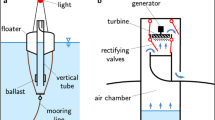Abstract
The earth, covered more than70.8% by the ocean, receives most of itsenergy from the sun. Solar energy istransmitted through the atmosphere andefficiently collected and stored in thesurface layer of the ocean, largely in thetropical zone. Some of the energy isre-emitted to the atmosphere to drive thehydrologic cycle and wind. The wind fieldreturns some of the energy to the ocean inthe form of waves and currents. Themajority of the absorbed solar energy isstored in vertical thermal gradients nearthe surface layer of the ocean, most ofwhich is in the tropical region. Thisthermal energy replenished each day by thesun in the tropical ocean represents atremendous pollution-free energy resourcefor human civilization. Ocean ThermalEnergy Conversion (OTEC) technology refersto a mechanical system that utilizes thenatural temperature gradient that exists inthe tropical ocean between the warm surfacewater and the deep cold water, to generateelectricity and produce other economicallyvaluable by-products. The science andengineering behind OTEC have been studiedin the US since the mid-seventies,supported early by the U.S. Government andlater by State and private industries.There are two general types of OTECdesigns: closed-cycle plants utilize theevaporation of a working fluid, such asammonia or propylene, to drive theturbine-generator, and open-cycle plantsuse steam from evaporated sea water to runthe turbine. Another commonly known design,hybrid plants, is a combination of the two.OTEC requires relatively low operation andmaintenance costs and no fossil fuelconsumption.OTEC system possesses a formidablepotential capacity for renewable energy andoffers a significant elimination ofgreenhouse gases in producing power. Inaddition to electricity and drinking water,an OTEC system can produce many valuableby-products and side-utilizations, such as:hydrogen, air-conditioning, ice,aquaculture, and agriculture, etc. Thepotential of these by-products, especiallydrinking water, aquaculture andmariculture, can easily translate intobillions of dollars in businessopportunities. The current status of theOTEC system definitely deserves to becarefully revisited. This paper willexamine recent major advancements intechnology, evaluate costs andeffectiveness, and assess the overallmarket environment of the OTEC system anddescribe its great renewable energypotential and overall benefits to thenations of the world.
Similar content being viewed by others
References
ATS Technology, Inc.(Advanced Thermal Systems, Inc.): 2003, ‘... and the Kalina cycle,’ http://www.advancedthermalsystems.com/technology.htm.
Claude, G.: 1930, ‘Power from the tropical seas,’ Mechanical Engineering 52(12), 1039–1044. Dauncey, G. and Mazza P.: 2003, Stormy Weather: 101 Solutions to Global Climate Change New Society, http://www.earthfuture.com
Daniels, T.H.: 2000, ‘Ocean thermal energy conversion: An extensive, environmentally benign source of energy for the future,’ Sustainable Development International 3rd edn., 121–125.
d‘Arsonval, A.: 1881, ‘Utilization des forces naturelles, Avenir de l‘electricite,’ Revue Scientifique 17.
DBEDT: 1993, Impact Analysis, Hawaii Model Energy Code, State of Hawaii, Department of Business, Economic Development and Tourism - Energy Division.
Krock, H.J. and Oney, S.K.: 2002, OCEES International, Inc., http://www.ocees.com
Lewis, B. and Ralph, M.: 2001, U.S. Department of Energy, Enhanced Geothermal Systems Conceptual Definition Study for the Harry Blundell Geothermal Power Plant Production Enhancement Project, DE-PSO7 00ID13913, including ‘Assessment of Expansion of Power Capacity at Roosevelt Hot Springs Geothermal Field, Beaver County, Utah,’ GeothermEx, Inc., and ‘Blundell Plant Expansion Heat Exchanger Test,’ Thermochem, Inc.
Massert, G.L.: 1974, ‘The tribulations of trying to harness thermal power,’ Marine Technology Society Journal 8(9).
Ministry of Economic Affairs and Technology: 1989, Solar Hydrogen Energy Carrier for the Future, Companion brochure for an exhibition prepared by the German Aerospace Research Establishment (DLR), the Solar and Hydrogen Energy Research Center (ZSW) and the Ministry of Economic Affairs and Technology for the State of Baden-Württemberg, Federal Republic of Germany.
Mirolli, M., Hjartarson, H., Mlcak, H.A. and Ralph, M.: 2002, ‘Testing and operating experience of the 2 MW Kalina cycle geothermal power plant in Húsavík, Iceland,’ OMMI 1(2).
Oney, S.K.: 1988, Molecular Diffusion of Oxygen and Nitrogen in Seawater, Masters Thesis, Department of Ocean Engineering, University of Hawaii.
Oney, S.K. and Krock, H.J.: 1989, ‘Noncondensable gas composition and outgassing rates in the open-cycle OTEC system with direct-contact condensation,’ in Proceedings of the First International Conference of Ocean Energy Recovery, Honolulu, Hawaii, American Society of Civil Engineers, pp. 307–316.
Oney, S.K.: 1993, Thermodynamic Analysis of an OC-OTEC System in the Direct-Contact Condenser Configuration Incorporating Predeaeration and Re-injection, Doctoral Dissertation, Department of Ocean Engineering, University of Hawaii.
Owens, W.L. and Trimble, L.C.: 1981, ‘Mini-OTEC operational results,’ ASME Journal of Solar Energy Engineering 103, 233–240.
Sea Solar Power (SSP Int.): 1998, 2002, 2003, Company Brochure, Presentations. http://www.seasolarpower.com
Solar Energy Research Institute (SERI): 1989, Ocean Thermal Energy Conversion - An Overview, SERI/SP-220-3024, November 1989.
Titsui, T., Ito, F., Seya, Y. and Nakamoto, Y.: 1983, ‘Outline of the 100 MW OTEC plant in the Republic of Nauru,’ IEEE Transactions on Power Apparatus and Systems PAS-102(9).
U.S. Congress: 1978, Renewable Energy Sources, Report of Office of Technology Assessment, U.S. Congress.
Vega, L.A.: 1995, Ocean Thermal Energy Conversion, Encyclopedia of Energy Technology and the Environment, New York, NY, John Wiley & Sons, Inc., pp. 2104–2119.
Vega, L.A., 2002, State of Hawaii Department of Business, Economic Development and Tourism (DBEDT) - OTEC, http://www.hawaii.gov/dbedt.ert/otec/index.html
Wall, G., Chuang, C.C. and Ishida, M.: 1989, ‘Exergy study of the Kalina cycle,’ in Analysis and Design of Energy Systems: Analysis of Industrial Processes, AES-10-3, pp. 73–77, ASME.
Wesström, Å.: 2001, A Feasibility Study for Building an OTEC Plant on Oahu, Hawaii, Master of Science Thesis in Heat and Power Technology, Technical Report No. 575/2001, Stockholm, Sweden, Department of Energy Technology, Royal Institute of Technology.
Zapka, M.J.: 1988, Gas Exchange in Seawater with Special Emphasis on Open-Cycle Ocean Thermal Energy Conversion, Ph.D. Dissertation, Department of Ocean Engineering, University of Hawaii.
Zapka, M.J. and Krock, H.J.: 1992, Seawater Pre-Deaerator for Open-Cycle Ocean Thermal Energy Conversion Applications, United States Patent No. 5,096,544, Research Corporation of the University of Hawaii.
Author information
Authors and Affiliations
Rights and permissions
About this article
Cite this article
Huang, J., Krock, H. & Oney, S. Revisit ocean thermal energy conversion system. Mitigation and Adaptation Strategies for Global Change 8, 157–175 (2003). https://doi.org/10.1023/A:1026062531405
Issue Date:
DOI: https://doi.org/10.1023/A:1026062531405




